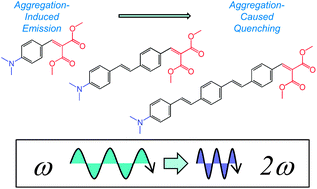Switching of emissive and NLO properties in push–pull chromophores with crescent PPV-like structures†
Abstract
We report on a series of novel homologous push–pull compounds, in which identical donor (a dimethylamino) and acceptor (a

* Corresponding authors
a
Department of Chemistry, University of Pavia, Viale Taramelli, 10–27100 Pavia, Italy
E-mail:
dario.pasini@unipv.it
Web: www.unipv.it/labt
Fax: +39 0382 987323
Tel: +39 0382 987835
b
Department of Chemistry, University of Milano and UdR dell'INSTM di Milano via Golgi, 19–20133 Milano, Italy
E-mail:
elena.cariati@unimi.it
Fax: +39 0250 314405
Tel: +39 0250 314370
c
Istituto per lo Studio delle Macromolecole (ISMAC), CNR, Via Bassini 15, 20133 Milano, Italy
E-mail:
chiara.botta@ismac.cnr.it
Fax: +39 0270 636400
Tel: +39 0223 699734
d Institute of Molecular Sciences and Technologies (ISTM), CNR, Via Golgi 19, 20133 Milano, Italy
e INSTM Research Unit, University of Pavia, Italy
We report on a series of novel homologous push–pull compounds, in which identical donor (a dimethylamino) and acceptor (a

 Please wait while we load your content...
Something went wrong. Try again?
Please wait while we load your content...
Something went wrong. Try again?
C. Coluccini, A. K. Sharma, M. Caricato, A. Sironi, E. Cariati, S. Righetto, E. Tordin, C. Botta, A. Forni and D. Pasini, Phys. Chem. Chem. Phys., 2013, 15, 1666 DOI: 10.1039/C2CP43140H
To request permission to reproduce material from this article, please go to the Copyright Clearance Center request page.
If you are an author contributing to an RSC publication, you do not need to request permission provided correct acknowledgement is given.
If you are the author of this article, you do not need to request permission to reproduce figures and diagrams provided correct acknowledgement is given. If you want to reproduce the whole article in a third-party publication (excluding your thesis/dissertation for which permission is not required) please go to the Copyright Clearance Center request page.
Read more about how to correctly acknowledge RSC content.
 Fetching data from CrossRef.
Fetching data from CrossRef.
This may take some time to load.
Loading related content
